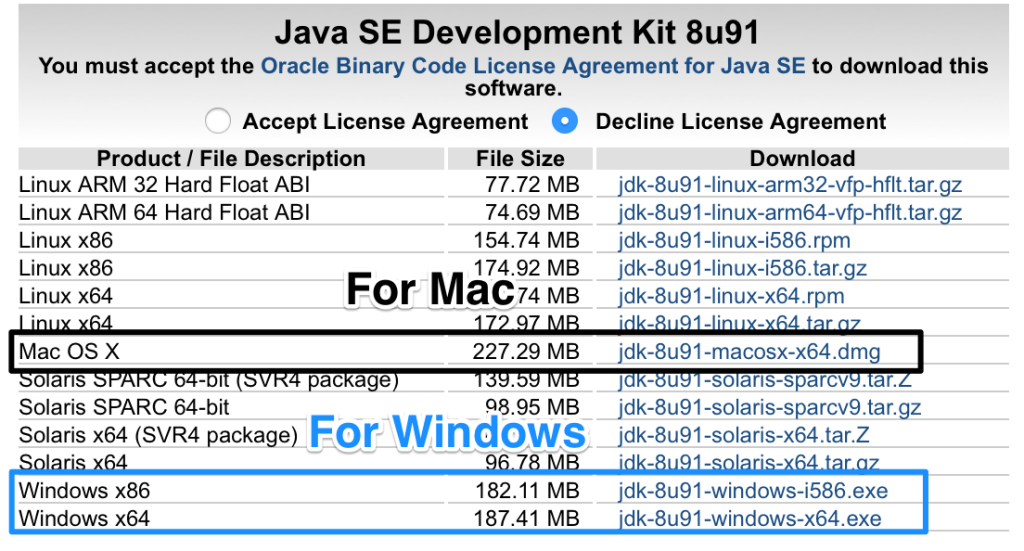- Install Java Jdk 8 Mac
- Mac Jdk Download
- Java Jdk Download Mac Mojave Dmg
- Jdk Download For Mac Os
- Free Jdk Download For Mac
Java is a general-purpose, secure, robust, object-oriented language developed by Sun Microsystems in 1990. Java is portable which means it follows to write once run anywhere paradigm. Many of the useful application are build on Java and required Java runtime environment. If you are preparing your system for the developing new java applications, you need to install JDK on your machine.
The latest version is Java 14 which was released in March 2020. This tutorial helps you to install Java 14 latest version or Java 11 LTS on macOS Sierra or High Sierra.
Install Java Jdk 8 Mac
Step 1 – Prerequisites
- JDK-8220150: macos macos10.14 Mojave returns anti-aliased glyphs instead of aliased B&W glyphs.
- This tutorial demonstrates how to download and install the OpenJDK 11 onto your MacOS devices, providing useful instructions and sample code to get you started. Java, jdk 11, mac os, tutorial.
- The Eclipse Foundation - home to a global community, the Eclipse IDE, Jakarta EE and over 375 open source projects, including runtimes, tools and frameworks.
And then check java - version and still showing java version '11.0.2' 2019-01-15 LTS – jcdsr Feb 26 '19 at 14:12 4 Note: this no longer works as of April 2019 because the java8 cask is gone.
Before starting the installation of Java using this tutorial you must have the following prerequisites
- Terminal: You must have Mac Terminal access and little knowledge about working with the terminal application. Ao login to your Mac system and open terminal
- Homebrew: This tutorial relies on Homebrew, So you must have homebrew installed. Homebrew can be installed with a single command.
For more instruction visit Homebrew installation tutorial.
Step 2 – Install Homebrew Cask

On Mac systems, Homebrew is the package manager, and Homebrew Cask is the app manager built on top of Homebrew. You Execute command to update brew cache and tap the caskroom/cask.

Step 3 – Install JAVA with Homebrew Cask
At the time of writing this tutorial the available version, Java 11 LTS and Java 14 latest for the installation.
- Check Available Versions – Use the following commands to view the details about java versions to be install.
- Installing Java – Next, install the Java version of your choice using one of the below commands. You can also install both versions if required.
The installation process may take some time to complete depending on your network speed.
- Check Version – Once the installation finished, verify the installed Java version.
All done. You have successfully installed Java on your macOS system.

Conclusion
In this tutorial, you have learned to install Java on macOS systems using homebrew.
By Tasnia Salinas, on January 31, 2020, in Mac Uninstaller
How to get started?
In this article, we help you to learn How To Completely Uninstall Java on Mac Mojave by using our dedicated Mac App Uninstaller software - Omni Remover. Make sure you have downloaded the latest version here before continuing.
Mac Jdk Download
What is Java and why do you need it on your Mac? Java is a set of computer software developed by James Gosling at Sun Microsystems, which was later acquired by the Oracle. Java provides a system for developing application software and deploying it in a cross-platform computing environment. Apple no longer includes a Java runtime with OS X as of version 10.7, but your Mac will prompt to download and install the latest version of Java the first time an application requiring the JRE is launched.
Why you should consider uninstalling Java Runtime on your Mac? The Java Runtime Environment (JRE) is what you get when you download and install Java software on your Mac. The JRE consists of the Java Virtual Machine (JVM), Java platform core classes, and supporting Java platform libraries. If you simply need Java JRE for one time use, or you're doing regular Mac cleanup for getting rid of useless clutters, then you can follow this article to learn how to disable and uninstall Java JRE on your Mac (Learn How To Completely Uninstall Eclipse Photon on Mac).

Java removal on Mac requires you have the Root/Administrator privileges. Also keep it in mind that, before you start, make sure you have backed up all the important data and files in case some unexpected errors occur. Once you finish the preparation, follow steps below to learn how to uninstall Java on your Mac manually (Learn How To Uninstall Anaconda on Mac).

- Step 1: Quit all applications that use Java. Since many video games, communication platforms, 3D content viewing applications, and so on require Java installed, it's suggested to close all running applications on your Mac.
- Step 2: Open Finder > Click Go on the left top corner and choose Go To Folder option > Enter this path in the appeared box: /Library/Internet Plug-ins/
- Step 3: In the Internet Plug-Ins window, you should find JavaAppletPlugin.plugin entry and delete it by grabbing it and moving to the Trash located on the Dock.
- Step 4: Use the same method to Finder > Go > Go To Folder > Enter the path ~/Library/Application Support/Java/ and delete Java folder.
- Step 5: After dragging the files associated with Java to Trash > Empty Trash and restart your Mac to finish the removal of Java.
As you can see, the manual way to uninstall Java on Mac is just over complicated and time-consuming. Omni Remover is one most advanced and efficient Mac App Uninstaller program, which makes the Java removal on macOS Mojave extremely easy. Here are the detailed steps about how to uninstall Java from Mac in 3 clicks (Learn How To Uninstall MacKeeper Mac).
Java Jdk Download Mac Mojave Dmg
Step 1:
Click here to download Omni Remover (Ready for macOS Mojave) > Install and Open Omni Remover on your Mac.
Step 2:
In Omni Remover > Extention Clean > Internet Plugins > Click Remove button on JavaAppletPlugin.plugin:
Step 3:
After uninstall Java plugins from your Mac Mojave, now run a thorough scan/clean on application cache junk. Click App Junk Clean option in Omni Remover > Start Scan:
Step 4:
After scanning Java and other Mac app leftover junk, click Clean Junk:
Step 5:
After one or two minutes, Omni Remover will finish cleaning up app junk and you can check how much free storage has been reclaimed:
Have you successfully uninstalled Java from your Mac Mojave with our methods above? If you still have questions, leave us a message in comment and we are glad to help. One more thing, apart from the ability of uninstalling your unwanted applications, plugins, preference panes (like Java) to reclaim more free storage on your Mac, Omni Remover is also capable of cleaning out cache junks in Xcode and Sketch. Free Download now to have a try.
Jdk Download For Mac Os
Omni Remover
Free Jdk Download For Mac
Version 3.3.5 (January 31, 2020) / Support macOS Catalina
Category: Mac Uninstaller